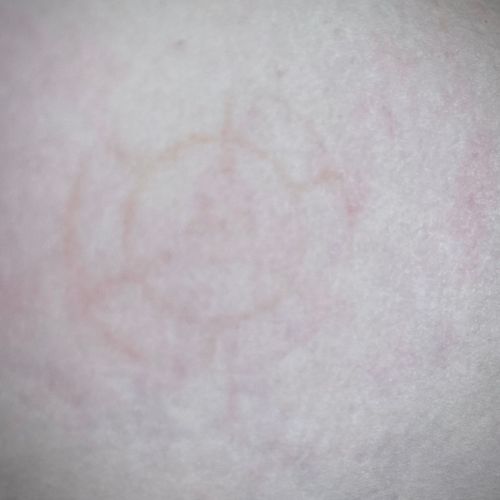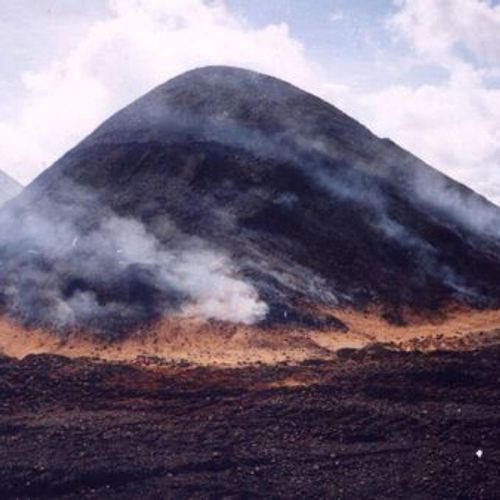
| Added | Tue, 04/10/2016 |
| Hierarchy | |
| Область распространения | All over the world |
| Характерные признаки |
→
→
→
→
→
→
|
| Sources | Чернобров В.А. «Полёты во времени» Книга 3
|
There are three main types of fire phenomena:
- Fiery poltergeist Phenomenon of glowing people Spontaneous spontaneous combustion In this article we will describe in more detail the phenomenon of spontaneous spontaneous human combustion.
Spontaneous combustion of a person is a phenomenon as a result of which a person can allegedly ignite without a visible external source of fire.
Legends about spontaneous combustion have come down to us from ancient times, but only since the beginning of the XVIII century, when such cases began to be recorded in official documents, including in police reports, they began to be considered sufficiently reliable.
For example, it is believed that the first mention of the phenomenon of spontaneous combustion was in the Bible: "The people began to murmur aloud against the Lord; and the Lord heard, and his anger was kindled, and the fire of the Lord was kindled among them, and began to destroy the edge of the camp. (Numbers 11:1)" In the old days, it was said about cases of spontaneous combustion that a person was burned by the "devil's fire", incinerated by Satan.
People believed that the victim sold her soul to the prince of darkness, but then violated their secret agreement, for which she was overtaken by retribution.
Later, in the XVII century, a more rationalistic explanation appeared: allegedly, chronic alcoholics become victims of spontaneous combustion, whose bodies are soaked in alcohol and therefore flare up from an accidental spark, especially if the deceased smoked.
Medieval literature also records cases of human spontaneous combustion: for example, during the reign of Queen Bona Sforza (between 1515 and 1557), the knight Polonius Vortius died in Milan in front of his parents and sons: after two buckets of drunk wine, he suddenly began to spew flames from his mouth and burned down.
More detailed evidence of human spontaneous combustion has been appearing since the XVIII century.
The very first documented story about spontaneous human ignition is considered to be a case that remained in the records of the Danish anatomist Thomas Bartolin. In 1663, he investigated and described a case of a woman in Paris "turned into ashes and smoke" while she was sleeping, but the straw mattress on which she was lying remained intact.
In 1731, under unclear circumstances, Countess Cornelia di Bandi died in the Italian city of Cesena: her legs, dressed in stockings, and part of her skull were found in the bedroom.
In April 1744, in Ipswich (England), the daughter of 60-year-old alcoholic Grice Peta found her father dead on the floor of the house: according to her, "he burned without fire, like a bundle of firewood." The clothes on the old man were practically intact, as they were made of asbestos.
The first reliable evidence of a case of human spontaneous combustion dates back to 1763, when the Frenchman John Dupont published a book with a collection of cases of human spontaneous combustion called "De Incendiis Corporis Humani Spontaneis". In it, among other things, he mentions the case of Nicolas Millet, who was acquitted of the charge of murdering his wife when the court was convinced that she died as a result of spontaneous combustion. Millet's wife, a heavy-drinking Parisian, was discovered at home when only a pile of ashes, a skull and finger bones remained from her. The straw mattress on which she was found was only slightly damaged, as it was impregnated with a non-flammable compound (obviously, this is a description of the case, which is considered the very first. see above).
Around 1853, in Columbus (Ohio), the owner of a liquor store, a German by nationality, caught fire and was devoured by flames with giblets. This case was invented by Charles Dickens in the preface to the second edition of his novel Bleak House, in which he described a fictional case of human spontaneous combustion.
In 1861, the literary critic and philosopher George Henry Lewis published his correspondence with Dickens, in which he accused the writer of spreading tall tales: "In these notes they usually write that greasy soot remains from the human body, and some remnants of bones.
Everyone knows that this can't be."
In 1870, an associate professor of forensic medicine at the University of Aberdeen published a note "On Spontaneous Combustion". In it, he wrote that he found about 54 modern scientists who have ever written about human spontaneous combustion, 35 of them unequivocally expressed their opinion about this phenomenon.
Five (including Justus Liebig) claimed that spontaneous combustion is impossible, and that all documented cases are a hoax.
Three (including Guillaume Dupuytren) believed that the cases of spontaneous combustion are real, but have a different nature, namely: there was some kind of external source of fire.
Twenty-seven scientists (including Deverji and Orfil) insisted that spontaneous combustion of the human body is quite possible. In the twentieth century, 19 phenomena of spontaneous human combustion were recorded.
A well-known forensic investigator from London, Doctor of Medicine Kevin Thurston, in 1961 published an article in the Medical Law Journal that "there are a number of absolutely reliable evidence of human combustion without the participation of any combustible substances in this process.
At the same time, as a rule, no damage is caused to flammable materials located nearby."
Throughout the existence of the phenomenon, many hypotheses have been proposed to explain this phenomenon.
- The human body, one way or another, is affected by various entities not from our world.
- The alcoholic's spiritualized body ignites from careless smoking.
- Spontaneous combustion is a well–disguised murder.
- A domestic accident. When flammable substances accidentally get on clothes and a small spark or gas leak is enough to ignite. For example, we can highlight the hypothesis of Alan Baird and Dougal Drysdale: suppose that a person works in a garage and usually cleans his clothes from detritus with a jet of compressed air, but this time he cleaned his overalls with a jet of pure oxygen, which temporarily, but very significantly increased the flammability of clothes. A lit cigarette is enough for a person to be engulfed in flames. Or the story comes from New Zealand, where in the 30s of the twentieth century explosive spontaneous combustion killed or injured farmers. Presumably, the reason for this was sodium chlorate (used as a herbicide against the harmful ragweed weed), which ignited spontaneously from everything except friction; it was especially sensitive to shocks. The effect of a human candle.
- The effect of a Human candle is a phenomenon when the victim's clothes are soaked in melted human fat and begin to act as a candle wick. Such a phenomenon can indeed occur under certain conditions. The theory assumes an external source of ignition: after it runs out, gorenje will continue due to the smoldering of fat. In judicial practice, there are several cases demonstrating the effect of this effect. The hypothesis of ignition from static electricity is based on the fact that under certain conditions the human body can accumulate such an electrostatic charge that clothes can catch fire when it is discharged.
- In 1996, John Hymer, analyzing a number of cases of spontaneous combustion, suggested that a psychosomatic disorder in people suffering from depression can lead to the release of hydrogen and oxygen from the human body and to the beginning of a chain reaction of mitochondrial microbursts.
- Russian researcher, Doctor of Physico-Mathematical Sciences Gennady Shipov agrees with his British colleague that pyrokinesis is a particular manifestation of poltergeist, when the human brain in an altered state of consciousness becomes a physical referent of spontaneous fluctuations of the quantum vacuum.
- Larry Arnold (chairman of the organization ParaScience International) in his book "Ablaze!" (1995) expressed the opinion that the cause of spontaneous combustion may be an as yet unknown subatomic particle called a pyroton emitted by cosmic rays. Usually this particle passes freely through the human body without causing harm (like a neutrino), but sometimes it can touch the cell nucleus and lead to a chain reaction capable of completely destroying the human body. This hypothesis was not supported. In the Fortean Times magazine, Ian Simmons reacted to this hypothesis: "There is no evidence of the existence of such a particle, and inventing it only to explain human spontaneous combustion is a stupid idea." Cases of human spontaneous combustion are caused by the discharge of ball lightning.
- The age hypothesis suggests that by old age, processes unknown to science begin to occur in the body, which can lead to spontaneous combustion.
- Some scientists suggest that an unknown metabolism in the human stomach and intestines may lead to the creation of flammable biological compounds. The Japanese Harugi Ito put forward a rather original version: the reason for spontaneous spontaneous combustion of a person is a change in the flow of time, when, due to some circumstances, physical processes (including the movement of atoms) sharply slow down inside the body, and their speed remains constant on the surface of the skin.
- In this case, the generated heat simply does not have time to radiate into space and incinerates a person. English chemist John Ronwald from Boston University announced that the culprit could be a special bacterium that "eats" sugar contained in the human body and produces volatile combustible substances.
- The only reassuring thing is that this bacterium has not yet been detected, it exists only in the form of a computer model.
- Today, a completely new, original hypothesis is gaining popularity among researchers of the phenomenon of pyrokinesis. According to her, in addition to the well-known types of fields, there is also a pyropole, which has the ability to heat protein matter.
- Candidate of Technical Sciences Anatoly Stekhin, senior researcher at the Research Institute of Human Ecology and Environmental Hygiene of the Russian Academy of Medical Sciences believes that the cause of spontaneous combustion of people can be considered cold plasma gorenje. "A person consists of three-quarters of liquid formations," the scientist claims. - Roughly speaking, out of the water. Free radicals in its molecules are able to "take away" energy. It can be either solar energy or biological. In exceptional cases, it bursts out in a stream of quanta. This is cold plasma gorenje. With it, the external body temperature does not exceed 36 degrees, and the internal reaches 2000 degrees. Almost twice as high as in the crematorium furnace!" Swiss scientist Ludwig Schumacher came to the conclusion that radiation and "energy beams" allegedly existing in nature, but unknown to science, interacting with the human biofield, can spontaneously cause a super-powerful flash, which leads to spontaneous combustion.
- {"AustrealAsia" 2001, N 14, p.108-109}[9]
- The ignition occurs from a "short circuit" of Qi energy in a person.
- The cause of spontaneous combustion is auto-suggestion. The principle is the same as that of stigmatists.
Features of the phenomenon that make it unexplained: The ignition of a person occurs from the inside.
- The internal organs are more damaged than the external ones.
- The fire occurs without a visible source.
- The surrounding objects are slightly damaged, even if they are highly flammable.
- The human body burns much more thoroughly during spontaneous combustion than during normal ignition. The injuries, however, are unevenly distributed throughout the body: sometimes a whole skull and, less often, limbs remain (sometimes partially ashes, and partially intact parts of the body). In order for human bones to turn into ashes, a temperature above 1700 °C is needed, while in crematoriums a temperature of about 1100 °C is used, and for the complete combustion of the corpse it is necessary to crush the bones.
Phenomenon in mass culture
Related versions
Related facts
Related news
Log in or register to post comments












